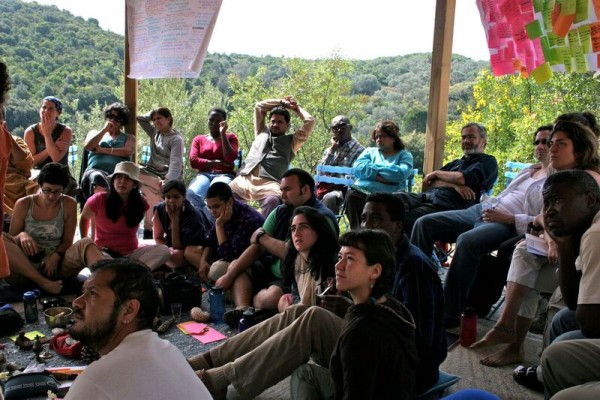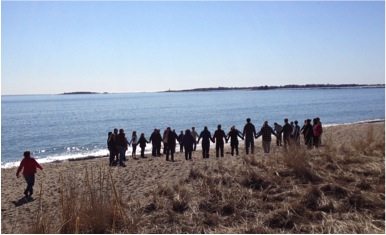We live in times of extreme partisanship, increasing divisions between the rich and poor, the working class and upper class, experiences of people of color vs. whites, and disconnects of people from nature. In the US, our current political process and social media tend to amplify divisions and generate more discord rather than consensus on common ground, stronger connections, and wise solutions balancing multiple needs.
When people are divided and disconnected, it is not surprising that there is a lack of empathy, curiosity, and care for the experiences and well being of people different than us. It can be easy to label people and disdain their views versus seeing them as individuals whose stories and struggles I understand and have talked with them about.
Finding new ways
It is time to find ways to work together that overcome patterns of division and separation.
This is already happening in many places, perhaps at  the edges and not that visible yet, but real nonetheless. Global communities of practice are inventing and evolving these processes (e.g., circle process, participatory processes, participatory budgeting, networks for system change.) While these experiments may seem at the edges when all the attention is focused on the mainstream political debate, they can hold seeds of a better way.
the edges and not that visible yet, but real nonetheless. Global communities of practice are inventing and evolving these processes (e.g., circle process, participatory processes, participatory budgeting, networks for system change.) While these experiments may seem at the edges when all the attention is focused on the mainstream political debate, they can hold seeds of a better way.
Over the last two years, I have been part of a rich dialogue with people who are exploring ways to bring people together that can help heal these long-standing harmful patterns. This group includes facilitators and others working with the Art of Hosting from Europe and the US. We facilitated a gathering in 2016 with 25 people where we experimented combining various methods in a prototype of how to host spaces for collective healing. We focused on several key themes of what is needed:
- Engaging across difference and connecting to “we” not just “me” – Getting beyond our narrow self interest to see ourselves as an inherent part of a larger group, community, society, and earth – and acting from that awareness – is not emphasized or easy to do. How can we facilitate groups in ways that generate a sense of belonging? How can we create group experiences that help us see those who are different not through the lens of a label but as full human beings with many stories, with complex emotions, and unique gifts and aspirations?
- Reweaving the fragments of community with positive collective experiences – The pressures and pace of work these days means many are chronically rushed, busy, addicted, and distracted. Then we can add in the challenges of the Covid pandemic and the social isolation. Fulfilling human experiences of connection, belonging, friendship, creativity, meaningful work, and the opportunity to work with others on a bigger cause are lacking. Changing these patterns starts with creating spaces for meaningful conversation about things that matter. Conversation is the “connective tissue” that can reconnect the fragmented parts.
- Trauma: the overlooked pattern affecting everything – Yet, even with these promising ways to gather people and generate ideas of how we can make things better, this is not enough. Any initiative to look forward and make positive change takes place in a community or system that has a long history, which we often overlook. The fragmented relationships, broken bonds of community, and lack of trust did not arise out of nowhere. There is a story there. Events of the past created harms and burdens that are often unacknowledged. These unhealed traumas can still be affecting the situation and the people involved…and blocking the potential to shift to a healthier pattern/outcome. Promising processes are emerging to help communities or societies explore and work with history in ways that can enable healing, for example systemic constellation, restorative justice, and truth and reconciliation commissions.
- Community and connection: healing together – One of the key ways to heal trauma is the experience of being truly heard and seen. When trauma is pushed under the rug, mental and emotional turmoil arises. Bessel van der Kolk writes “Denial of the consequences of trauma can wreak havoc with the social fabric of society.” What can we do to create a strong fabric of community while coming together and acknowledging the traumas? How can we generate a shared understanding and commitment to change so we do not repeat these harmful patterns?
- Accessing overlooked human capacities – In much of the work world, there are unwritten rules of being professional and successful: use your intellect and leave your emotions at the door. Yet, we need to access human capacities, such as empathy and compassion, to understand the experiences and motivations of all those within a community and society. We are only beginning to explore how mindfulness and presence can help us understand past and present dynamics and make decisions. And there is more potential to explore weaving in arts, music, movement, and creative expression, which also tend to be left at the door. What could be possible in our collective work if we did not expect people to split off their emotional, intuitive, and creative sides to “be professional?” How might we make decisions if we access the power of “collective presence?”
 There is a hunger for this…
There is a hunger for this…
In my work with non-profits, communities, businesses, governments, and foundations in social and environmental change, I have seen that: These practices work. There is a hunger for real conversation, for connecting to our larger community to achieve greater results together, and for contributing to making the world a better place.
